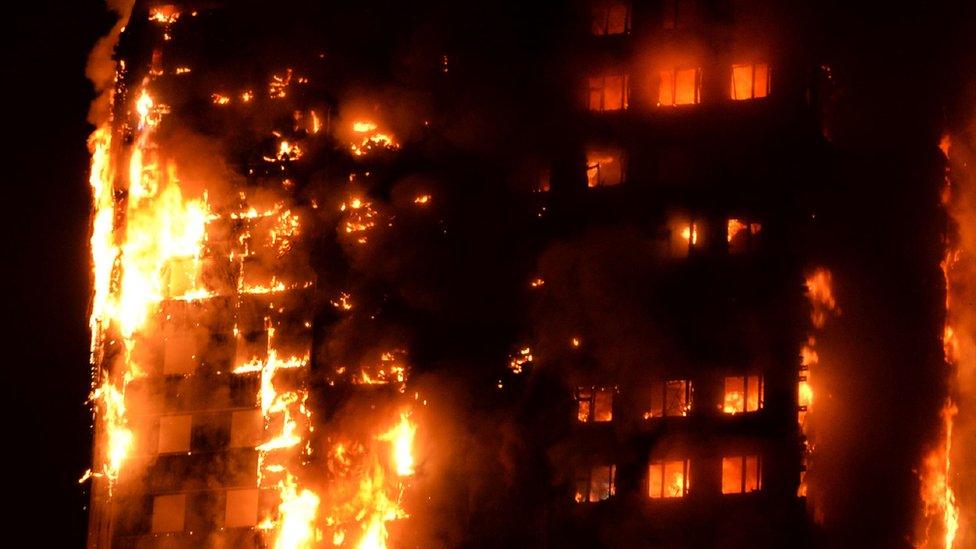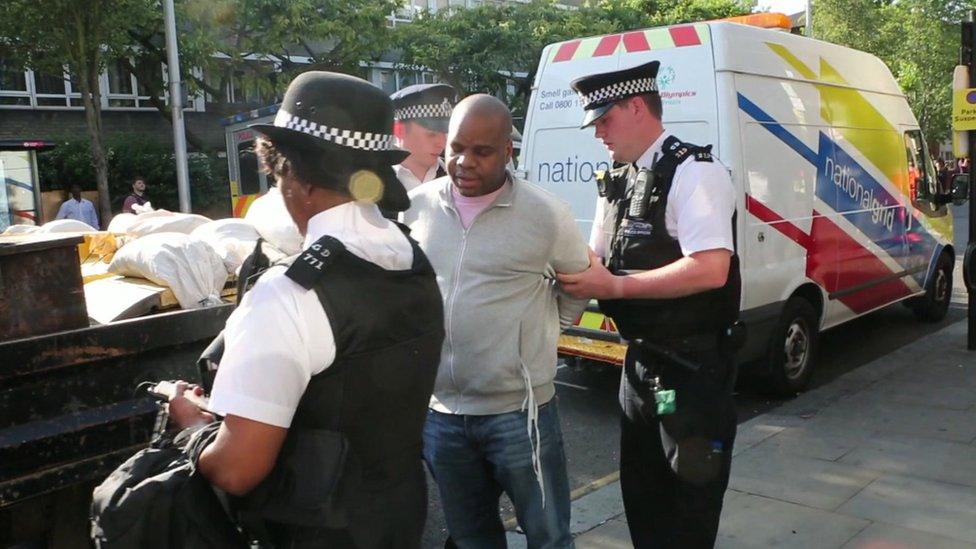'Why I posted photos of Grenfell victim on social media'
- Published
Omega Mwaikambo was jailed for three months
Omega Mwaikambo pauses, glances to one side then blinks as he ponders the question he has asked himself every day for the last three months.
"Why did he take photographs of a dead victim of the Grenfell fire - and then post them to Facebook?"
His answer - given to BBC Newsnight in his first interview since leaving Wandsworth prison earlier this month, after being sentenced to three months for taking and sharing the pictures - should serve as a warning for all social media users
Mwaikambo, a 43-year-old chef born in London to Tanzanian parents, returned from work to his home next door to Grenfell Tower at about 00:15 BST on 14 June.
About 01:00 - just as he drifted off to sleep - he started to hear strange noises.
"I heard a faint sound of 'help, help'", Mwaikambo said.
"At first I dismissed it. Then it happened again. And again. So I got out of bed to investigate."
Mwaikambo's first instinct, he said, on seeing the fire, was to run to warn his neighbours.
He then joined the throng of locals gathered beneath the tower.
He saw trapped residents screaming and waving for help. Others he saw jumping to their deaths.
"It was sort of like watching the 11 September World Trade Center", he told BBC Newsnight.
"But this was real, in front of my eyes."

Mwaikambo lived next to Grenfell Tower
It was about 05:00, as he returned home to his flat, that Mwaikambo spotted the body.
A corpse, wrapped in plastic, apparently dumped in the enclosed courtyard area outside his flat's front door.
"God knows what I was thinking in my head," he explained.
"But I was holding my iPad. The body was not wrapped tightly; it was loosely wrapped.
"Inside I was just saying to myself 'does anybody know this person?' I just took the picture."
Mwaikambo started off by taking photos of the body bag from a distance. Then he went further. He lifted the plastic sheeting around the corpse's face, and took more.
"[I was] not even knowing what I was doing." he said.
"It just happened. No explanation. But with anger. [I was] traumatised. Mesmerised as well.
"Morally I know it was wrong. But it was not morally right for a body - for its respect - to be left unattended out there."
'I'd do it again'
Then came the move that pushed Mwaikambo's actions into the criminal. He uploaded seven of the pictures, plus one short video, to his Facebook page.
Mwaikambo did so, he now claims, in anger and confusion.
But also, he says, out of habit. Posting regular status updates to his Facebook page is, for him, just "something he does".
His Facebook account was set to "open", meaning anyone with an internet connection could see his pictures if they looked.
But even then the pictures didn't go viral. It took the involvement of someone else - professional photographer Jason Kay - for the police to get involved.
Around 08:00 that morning, Mwaikambo met Mr Kay, who had just arrived on the scene. He offered him use of all his photographs from the previous night.
Mr Kay thanked him - then informed the police.
"I felt I had to report that to the authorities given the circumstances," he told Newsnight.
"I did turn him into the cops. I'd do it again. Absolutely. 100%."

Omega Mwaikambo was arrested on 14 June
What about the arrest? Did Mr Kay help the police arrest Mwaikambo?
"The police said 'do you know where he is now?'," he explained.
"I said, 'I've got his mobile number - I can give him a call'.
"They were there to meet him and greet him and seize his iPad and everything else."
Mwaikambo was arrested outside Latimer Road Tube station at around 18:00 on 14 June; 17 hours after the fire took hold.
He appeared in court two days later, where he pleaded guilty to two charges of breaching the 2003 Communications Act by posting offensive images to a social media network.
The first of the two charges related to two photos and a video of the body bag's exterior. The second charge related to five photos of the body inside a body bag.
District Judge Tanweer Ikram was unforgiving.
"The whole country, if not the whole world, has been shocked by what has taken place in the last few days in relation to the fire at Grenfell Tower," he told Mwaikambo.
"What you have done by uploading those photos shows absolutely no respect to this poor victim. To show his face as he lies there is beyond words."
Judge Ikram sentenced Mwaikambo - who had no criminal record - to six weeks in prison for each crime. A total of three months inside.
The photographer who informed the police of Mwaikambo's actions, Mr Kay, told Newsnight he was shocked by the sentence.
His objective in informing the police "wasn't getting [Mwaikambo] sent to prison", he said.
"When they said he had got three months, I was like 'really?' Do you not think that was the system turning around and sending a message to society?"
Mwaikambo acknowledges that he broke the law, and that he acted immorally. But he remains confused and upset by his treatment.
"It's just a picture," he says.
"I didn't steal. I didn't kill. I didn't commit any crime that I know is really a high risk.
"I can understand why people are angry.
"Why would anybody take a photo of a dead person, if they were in a normal state of mind?
"Why would anybody do such a thing?"